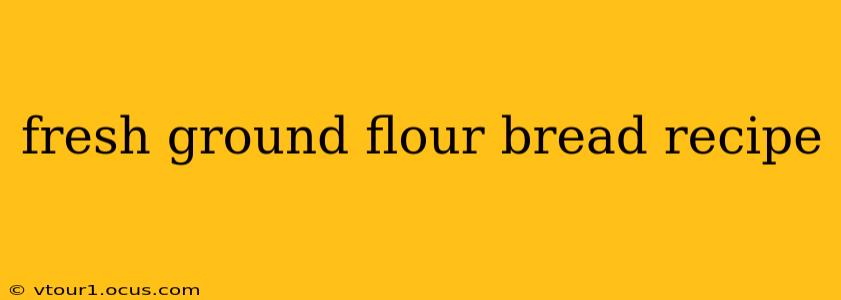The aroma of freshly baked bread, made with flour ground just hours before, is an unparalleled sensory experience. This recipe guides you through creating a truly exceptional loaf, highlighting the unique benefits of using freshly ground flour. Using freshly ground flour isn't just about taste; it’s about unlocking the full potential of your grains, resulting in a bread with a superior texture and nutritional value.
Why Freshly Ground Flour?
Before we dive into the recipe, let's explore why grinding your own flour elevates your baking. Freshly ground flour boasts a superior nutritional profile compared to commercially milled flour, as it retains more of its essential nutrients and enzymes. The delicate bran and germ, often removed during commercial milling, remain intact, contributing to a richer flavor and a more complex nutritional composition. This results in bread that is not only more flavorful but also potentially healthier.
What You'll Need:
Ingredients:
- 3 cups freshly ground whole wheat flour (or a blend of whole wheat and white wheat)
- 1 cup freshly ground white bread flour (or all-purpose flour if using a higher protein whole wheat)
- 1 ½ cups warm water (around 105-115°F)
- 1 ½ teaspoons active dry yeast
- 1 ½ teaspoons salt
- 2 tablespoons olive oil (or other neutral oil)
- Optional: 1 tablespoon honey or sugar (to feed the yeast)
Equipment:
- Grain mill (burr mill is recommended for consistent grind)
- Large mixing bowl
- Measuring cups and spoons
- Plastic wrap or a damp kitchen towel
- Loaf pan (approximately 9x5 inches)
- Baking sheet
- Pastry scraper or spatula
Step-by-Step Instructions:
-
Grind Your Flour: Begin by grinding your grains using a quality burr mill. The grind should be consistent; too fine and you'll get a gummy dough, too coarse and you may have a less cohesive loaf. Adjust your mill accordingly for the desired consistency. Aim for a medium-fine grind.
-
Activate the Yeast: In your large mixing bowl, combine the warm water and yeast. If adding honey or sugar, add it now as well. Let it sit for 5-10 minutes until foamy. This indicates the yeast is active and ready to work its magic.
-
Combine Ingredients: Add the olive oil, salt, and the freshly ground flour to the yeast mixture. Mix with your hands or a wooden spoon until a shaggy dough forms. It will be sticky at this stage.
-
Knead the Dough: Turn the dough out onto a lightly floured surface. Knead for 8-10 minutes, adding a little extra flour if necessary to prevent sticking. The dough should be slightly sticky but not overly so. The kneading develops the gluten, which is essential for a good structure in your bread.
-
First Rise (Bulk Fermentation): Place the dough in a lightly oiled bowl, turning to coat. Cover the bowl with plastic wrap or a damp kitchen towel and let it rise in a warm place for 1-1.5 hours, or until doubled in size.
-
Shape the Loaf: Gently punch down the dough to release the air. Shape it into a loaf and place it in your greased loaf pan.
-
Second Rise (Proofing): Cover the loaf pan and let the dough rise for another 45-60 minutes, or until it almost reaches the top of the pan.
-
Bake the Bread: Preheat your oven to 375°F (190°C). Bake for 30-35 minutes, or until the bread is golden brown and sounds hollow when tapped on the bottom.
-
Cool and Enjoy: Remove the bread from the oven and let it cool completely on a wire rack before slicing and serving. This allows the crumb to set properly.
Frequently Asked Questions (FAQs)
Can I use pre-ground flour instead of freshly ground?
While you can, using pre-ground flour will not deliver the same flavor and nutritional benefits as freshly ground flour. The longer flour sits, the more its nutrients degrade.
What type of grain mill should I use?
A burr mill is highly recommended for consistent grinding. Blade mills tend to produce a less uniform grind, which can affect the bread's texture.
What if my dough is too sticky?
Add a little more flour, one tablespoon at a time, until the dough becomes easier to handle. However, be mindful not to add too much, as this can result in a dry loaf.
How do I know if my yeast is active?
Active yeast will create a foamy head on top of the water mixture within 5-10 minutes. If this doesn't happen, your yeast may be dead, and you should start with a fresh batch.
Can I use other types of flour?
Absolutely! You can experiment with different blends of whole wheat, rye, spelt, or even add some oat flour for a unique flavor. Just remember to adjust the hydration (water content) as needed, depending on the flour's protein content.
Enjoy your freshly baked, freshly ground flour bread! The taste and texture will be a testament to the quality of your ingredients and your baking efforts. Remember to adjust baking times depending on your oven and the size of your loaf. Happy baking!
